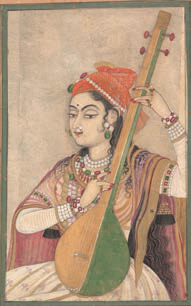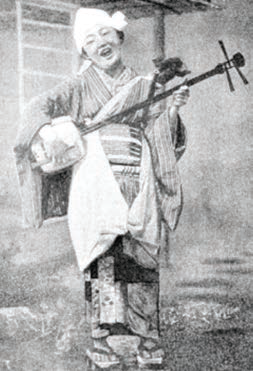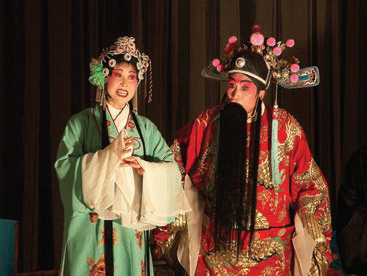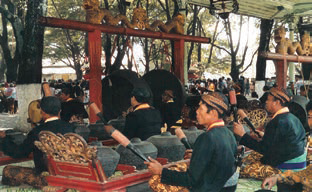1.5: Asian Music
- Page ID
- 238538
India
Indian classical music is almost always performed in small groups. Indian musicians do not use scales and harmony like we do in our Western music. Their music includes improvisation and is based on rhythmic melodic patterns. The example here is a traditional improvised Indian piece that employs the stringed sitar and the tabla drum.

The melodic patterns Indian music uses are called raga, which are more of a shape than a scale. The rhythmic patterns are called tala, which are established patterns that repeat over and over. Often the raga and tala don’t line up exactly, so there never seem to be any repeated sections. Indian musicians use a large stringed instrument called a sitar, and stretched skin drums called tabla.
Music - Ravi Shankar - Raga Ramkali
Japan
Like Indian music, Japanese music is also performed in small groups and uses pentatonic scales, but that is where the similarities end. Japanese folk music is not improvised. Rather, it is composed and is almost always built around lyrics that are either borrowed from poetry or composed for the specific song. The music is made up of regular rhythms, but there is no intentional harmony as in Western music. Japanese musicians pride themselves on memorizing each composition and then performing it exactly the same way every time. They use a large thirteen string instrument called a koto, and an end blown flute called a shakuhachi. Listen for the koto and the shakuhachi in the traditional Japanese selection below.

Figure \(\PageIndex{1}\): Japanese folkwoman playing shamishen. (Public Domain; Christopher Wagner via Wikimedia Commons)
Japanese Music – Tsuki no shizuku (Played on Koto and Shakuhachi)
China
At first glance, Chinese Opera is not that different than Italian Opera in that it is a musical drama incorporating costumes, song, and dance. However, a closer examination reveals that the music of Chinese Opera differs greatly from Western opera. Chinese Opera singing style often involves singing melodies derived from the pentatonic scale. Also, Chinese singers can be heard sliding between notes of the melody, giving the music a “slippery” quality that is unique to Eastern Music. Give this piece a listen, and you will hear this quality!

Figure \(\PageIndex{1}\): Sichuan Opera in Chengdu. (CC BY-SA 3.0; User “Zoharby” via Wikimedia Commons)
Chinese Opera
Indonesia
When we think of a gong, we often envision a large brass thing that looks like a giant cymbal. True, gongs come in many different sizes and can actually be used to play melodies but this often envisioned image is one variant of a gong named tamtam. In Indonesia, gongs have been used in traditional music for centuries. The following video shows musicians using many different sized gongs while performing Indonesian music.

Munggang, Kraton Surakarta. (CC BY-SA 3.0; Giovanni Sciarrino via Wikimedia Commons)

